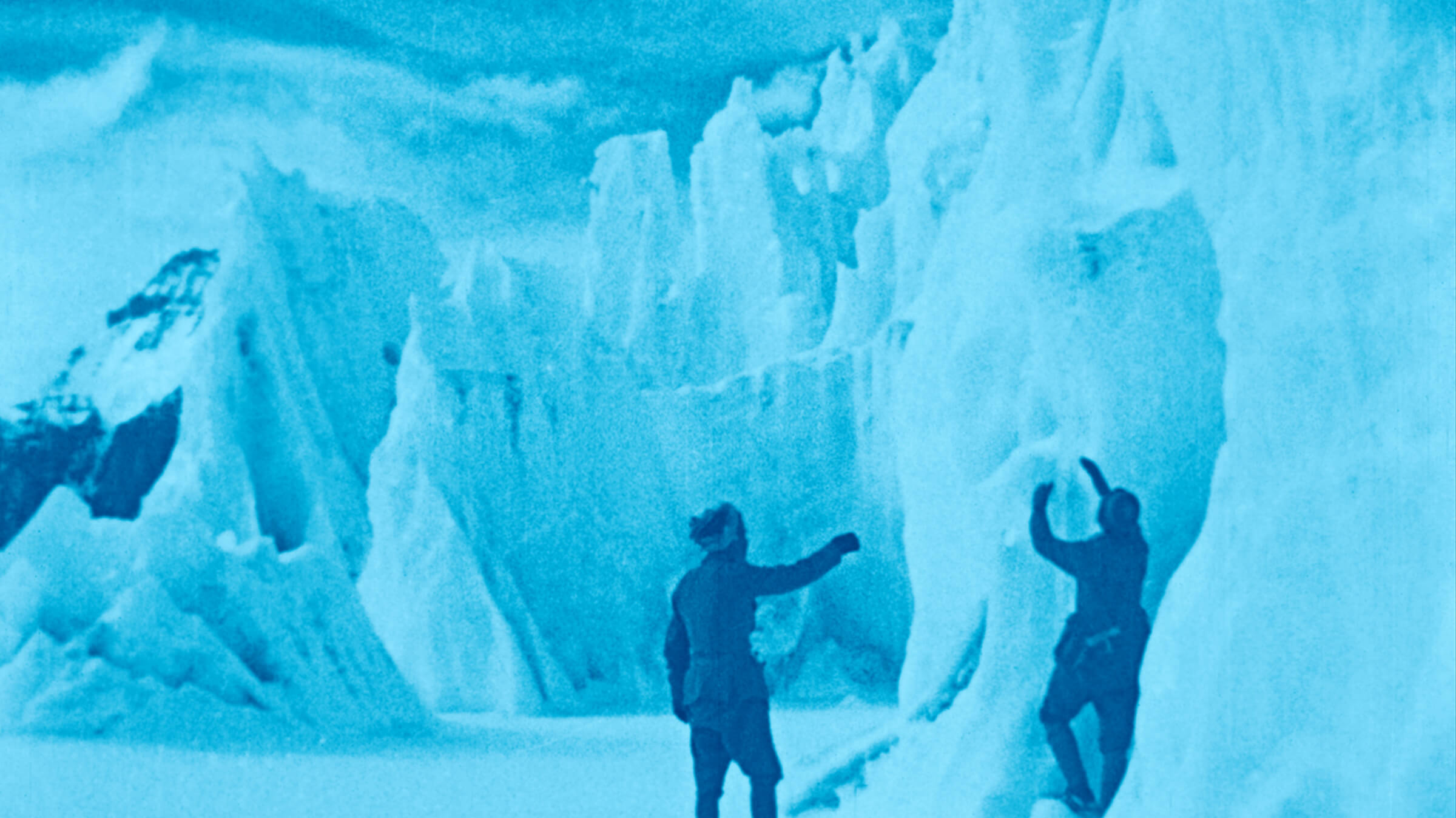The idea of the filmmaker as a modern-day explorer is as old as cinema itself. As soon as the Lumière brothers introduced their lightweight motion picture cameras in 1895, operators began setting out around the globe to produce actuality films. Within 20 years, enterprising filmmakers like Herbert Ponting (The Great White Silence), Edward Curtis (In the Land of the Head Hunters), Frank Hurley (Pearls and Savages), and Robert Flaherty (Nanook of the North) expanded on those early actualities by yoking ethnographic subjects to dramatic staging and editing. Epic of Everest filmmaker Captain John Noel was one of these forebears of “documentary”—the coinage dates to John Grierson’s 1926 review of Flaherty’s Moana—though today his name is not so well remembered.
Noel’s feat became overshadowed by the ill-fated 1924 Mount Everest expedition, which claimed the lives of two celebrated climbers, George Mallory and Andrew “Sandy” Irvine. Their deaths at the top of the world provided England with a saving grace of courage and valor following the countless ignominies suffered in the trenches of World War I. Noel’s film helped establish a redemptive vision of the failed expedition. Astonishing purely as a technological achievement, The Epic of Everest’s larger significance lies in its power as a national myth.
1924 was not Noel’s first time up the mountain. He initially approached the Himalayas secretly, in 1913, donning a disguise to slip through a Tibetan embargo on British exploration. His service during the Great War was marked by similar daring. Taken prisoner in the Battle of Le Cateau, he made it back to the British side after a ten-day trek, only to be sent back to combat in time for the Second Battle of Ypres when the Germans first deployed poison gas on the Western Front. He was later diagnosed with neurasthenia—“shell shock,” as it was soon to be called.
Noel remained fixated on Everest throughout the war, and, in 1919, he delivered a rousing speech to the Royal Geographic Society often credited with inspiring the expeditions of 1921, 1922, and 1924. He was as far from the “disinterested observer” as you could imagine—not that passivity was an option on Everest. The Mount Everest Committee selected Noel to accompany the 1922 expedition in order to make Climbing with Everest (1922); the film was well received, but Noel, like the rest of the expedition, was eager for another crack at greatness. His preparations for the subsequent 1924 expedition involved numerous technological innovations: a newly constructed film lab in Darjeeling; special camera motors permitting time-lapse exposures; and powerful telephoto lenses to film action at three thousand yards. Everest dictated the terms, but Noel wrangled the effects: time-lapse shots conveying capricious weather systems swirling around the mountain’s peak and long-range cinematography detailing the heroic attempt in fittingly existential scale. Noel’s obsession with capturing splendid natural effects even extended to the film’s color tinting, done by hand in accordance with values carefully recorded on location and brilliantly bold in the new British Film Institute restoration.
The film was no less innovative in its financial packaging. With the Everest Committee struggling to secure adequate funds after the disappointing 1922 trek, Noel stepped in with a guarantee of 8,000£, made with the understanding that his production company, Explorers’ Films, was to own the rights to all photographic and film documentation of the expedition. As Wade Davis writes in Into the Silence: The Great War, Mallory, and the Conquest of Everest, “The quest for the highest summit slipped from imperial venture to commercial opportunity.” It was nevertheless a tremendous gamble—a successful run at the summit would mean a smashing success. In the event, Mallory and Irvine’s deaths all but assured that The Epic of Everest was to become the focus of an unprecedented outpouring of grief.
Editing the film, Noel struggled for a sense of novelty to balance the tragedy waiting at the end, a problem he tried to address by adding “large doses of local colour.” Noel certainly wasn’t alone among his peers in blending ethnography and entertainment, though his treatment of Tibetan culture remains especially unnerving. The deaths of two porters—Darjeeling cobbler Manbahadur and Gurkha Lance Corporal Shamsherpun—do not even merit a full intertitle, while the treatment of daily life and rituals hovers between superciliousness and derision. Early screenings were accompanied by fanciful set design and a full-bore performance of religious rites by a group of seven Tibetan monks. Needless to say, the authorities in Lhasa, already skeptical of the British expeditions, were not pleased by this circus. Davis logs several levels of diplomatic protest: the maharaja of Sikkim barred Noel from reentering the country, the Dalai Lama called for the arrest of the seven traveling monks, and the Tibetans prohibited additional British expeditions (another attempt wasn’t made until 1933). It is difficult to think of another documentary of this or any other era having such tangible consequences on international relationships.
Watching The Epic of Everest today, the condescension of Noel’s narration smacks not only of cultural insensitivity but also of a desperate effort to master the narrative of yet another failed British expedition. The telescopic views of the climbers attempting to scale the peaks are technological marvels, to be sure, but as we watch these tiny figures moving across the landscape, the shots also come to express the overpowering desire on the part of the British audience to see something in Mallory and Irvine’s doomed attempt. The intimate address of the film’s final title card—“If you had lived, as they had lived and died in the heart of nature, would you, yourself, wish for any better grave than a grave of pure white snow?”—makes it clear that the real subject of The Epic of Everest is not Mallory and Irvine but rather their hold on the British imagination.
Presented at SFSFF 2014 with live music by Stephen Horne and Frank Bockius

